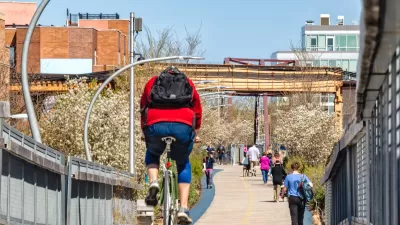Jarrett Walker outlines the conditions under which transit serves the greatest number of travelers. Maximizing ridership, he argues, requires thinking like a business and catering to demand.

In an article on his blog, Jarrett Walker writes, "Maximizing ridership is like maximizing the number of customers for any business. You have to think like a business, and the first thing businesses do is choose which markets they will enter. Unlike governments, businesses feel no obligation to provide their service in places where they would spend a lot of money to serve very few people."
Walker differentiates ridership from transit coverage, which is often a politically-motivated goal. "Commentators sometimes criticize transit authorities for low ridership, as though transit were a failing business. But transit authorities are rarely directed to maximize ridership as their primary goal, so they're not failing if they don't."
"A more precise question is: 'what percentage of our resources should our transit authority spend pursuing maximum ridership?' When transit authorities answer that question, then everyone knows what the purpose of the service is."
Walker explains in detail the factors behind transit demand. They include:
- Frequency of service: "People who are used to getting around by a private vehicle (car or bike) often underestimate the importance of frequency, because there isn't an equivalent to it in their experience."
- Overall diversity of trips served (as opposed to personalized service)
- Travel time, including time spent waiting
Finally, Walker discusses how the urban landscape affects ridership, focusing on density, walkability, linearity, and proximity.
FULL STORY: Explainer: The Transit Ridership Recipe

Depopulation Patterns Get Weird
A recent ranking of “declining” cities heavily features some of the most expensive cities in the country — including New York City and a half-dozen in the San Francisco Bay Area.

Pennsylvania Mall Conversion Bill Passes House
If passed, the bill would promote the adaptive reuse of defunct commercial buildings.

California Exodus: Population Drops Below 39 Million
Never mind the 40 million that demographers predicted the Golden State would reach by 2018. The state's population dipped below 39 million to 38.965 million last July, according to Census data released in March, the lowest since 2015.

Google Maps Introduces New Transit, EV Features
It will now be easier to find electric car charging stations and transit options.

Ohio Lawmakers Propose Incentivizing Housing Production
A proposed bill would take a carrot approach to stimulating housing production through a grant program that would reward cities that implement pro-housing policies.

Chicago Awarded $2M Reconnecting Communities Grant
Community advocates say the city’s plan may not do enough to reverse the negative impacts of a major expressway.
City of Costa Mesa
Licking County
Barrett Planning Group LLC
HUD's Office of Policy Development and Research
Mpact Transit + Community
HUD's Office of Policy Development and Research
City of Universal City TX
ULI Northwest Arkansas
Town of Zionsville
Urban Design for Planners 1: Software Tools
This six-course series explores essential urban design concepts using open source software and equips planners with the tools they need to participate fully in the urban design process.
Planning for Universal Design
Learn the tools for implementing Universal Design in planning regulations.


























